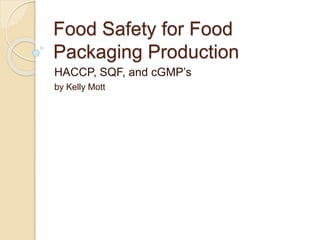
Food Safety for Food Packaging Production
- 1. Food Safety for Food Packaging Production HACCP, SQF, and cGMP’s by Kelly Mott
- 2. What is HACCP? (pronounced hassup) Hazard Analysis Critical Control Point
- 3. A HACCP plan is how we control risks to food safety. If a risk is identified, it is brought down to an acceptable level, or eliminated completely.
- 4. What are the types of potential risks to food safety? Biological- bacteria, viruses, parasites Physical- hair, metal shavings, glass; anything that can cause physical harm or discomfort Chemical- Cleaners, lubricants, paints, pesticides Allergenic- Peanuts, tree nuts, fish, shellfish, milk, soy, eggs, wheat
- 5. HACCP IS BASED ON SEVEN PRINCIPLES 1) Conduct a hazard analysis 2) Identify the critical control points 3) Establish critical limits 4) Establish monitoring procedures 5) Establish corrective actions 6) Establish record keeping procedures 7) Establish verification procedures
- 6. WHAT IS SQF? Safe Quality Food SQF is our food safety management system certification based off of our HACCP plan. Maintaining a SQF level three certification assures our customers that our products are of the highest quality and safe for packaging their food products.
- 7. Why SQF? Mandated by our customer It contains requirements for integrated processes that work together to control and minimize food safety hazards. Recognized worldwide Promotes confidence in food safety, quality and legality Enhances marketing image
- 8. What is your role in HACCP and SQF? cGMP’s! ◦ current ◦ Good ◦ Manufacturing ◦ Practices Always improving and changing, that is why the word “current” has been added
- 9. cGMP’s are listed in the US FDA’s Code of Federal Regulations Title 21
- 10. Organization and Personnel Have a Quality Unit with responsibility to reject or approve all material, procedures, and specifications Everyone will have sufficient training, knowledge and experience to do their job Wear clean clothing Wear protective apparel to prevent contamination (hair nets, gloves, cutting gloves) Practice good sanitation- wash your hands!!!! If you are sick or have open lesions, do not handle food/medical product.
- 11. Building must be adequately sized for proper storage of equipment and material Operations will be performed in specific areas Rejected material will be separated and placed in quarantine There will be adequate lighting There will be adequate environmental controls Sewage and trash will be stored and disposed of in a safe and sanitary manner Buildings and facilities
- 12. Adequate washing and toilet facilities will be available Building will be maintained in a clean and sanitary manner There will be cleaning schedules with approved cleaning agents Buildings in good state of repair Buildings maintained pest and rodent free Written procedures and approved chemicals for pest control Buildings and facilities- cont.
- 13. Equipment Will be maintained in a good state of repair ◦ Written schedule of maintenance Will be cleaned ◦ Written schedule of cleaning ◦ Clean between jobs Use approved cleaning agents ◦ Agents that will not affect products ID number on equipment
- 14. Raw Materials Written procedures on receipt, handling, and sampling Stored off the floor Must be secured and protected from contamination (lids on boxes and bins, silos and vacuum tubes capped) Clearly marked with name/code of material and lot number
- 15. Production and Process Control There will be written procedures Document activities Control contamination Cleanliness Organization Work area cleared of other job information (packaging, labeling) prior to start of next job
- 16. Warehouse It shall be clean Sections clearly identified First In- First out Inventory tracking system
- 17. Laboratory Will have specifications, standards, sampling plans, test procedures Shall have a calibration and maintenance program ◦ Written with a time period for performance Document all testing Tell your supervisor immediately if something is wrong Reserve samples will be kept for a determined period of time (we keep our sample retains for six months)
- 18. Documentation Records will be maintained of production, testing/quality checks, training, maintenance, cleaning, almost everything! If it was not documented, it did not happen! Written in ink NO white-out is allowed Correct paperwork errors by drawing a single line through the error; initial and date Sign only what you performed of verified Write down the correct date ◦ Do not write down a previous date ◦ If you forgot to sign something on a previous date, correct it by writing, “Performed on MM/DD/YY, written on MM/DD/YY”
- 19. By following all cGMP’s, you do your part to follow our HAACP plan and maintain our SQF certification. We are a team!
- 20. THANK YOU